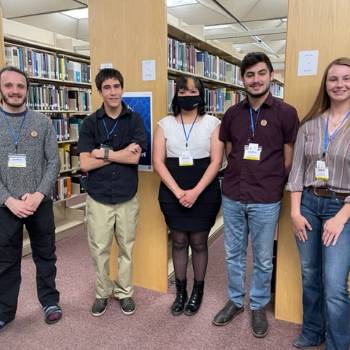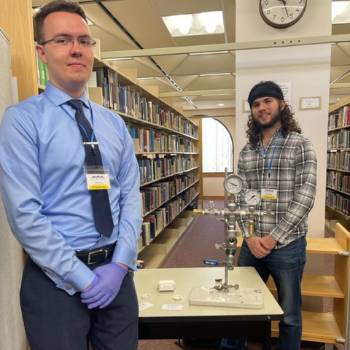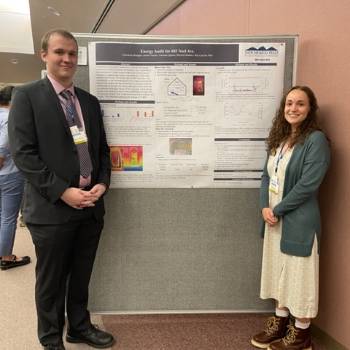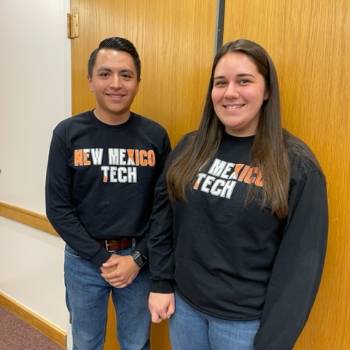Funding Helps Students Pursue Sustainable Design Projects
April 25, 2022

SOCORRO, N.M. – Funding from an anonymous donor and from the New Mexico Society of Professional Engineers made the difference for students pursuing sustainable design and energy and environmental research projects this year at New Mexico Tech. Gifts from donors helped pay for materials, equipment, and testing supplies crucial to the projects’ success, allowing the students to perform their research, participate in national competitions and conferences, and showcase their work at the university’s 11th annual Student Research Symposium, held April 20 to 22 at the Joseph R. Skeen Library.
The $5,000 in annual funding from donors via New Mexico Tech’s Advancement Office was specifically targeted for the sustainable design projects was funneled to the Materials Engineering and Environmental Engineering departments for student projects.

Three student teams pursued case studies of residential energy loss pathways. Performing energy audits of houses in the Socorro area, students were able to identify energy inefficiencies – such as heat loss through doors, windows, and poorly insulated areas of the structures. Students also evaluated energy loss consumption records and performed tests, such as draft assessments with a fogger and a blower door and infrared imaging with a thermal imaging camera. Donor funds were used to pay for the use of equipment to perform the tests.
Students then compiled lists of recommendations for the homeowners for how they could make improvements or possibly opt for solar panels to decrease energy costs.

“Little things make a big difference in energy efficiency,” said Jonathan Taylor, one of five members of a team that presented its “Case Study of Residential Energy Loss Pathways” during a poster session at the Student Research Symposium April 20.
Charlotte Dungan, a master’s student in civil and environmental engineering originally from Georgia, said energy audits could lead more homeowners to consider or switch to solar energy.
“I really hope in the future everybody uses it,” she said. “There’s a lot of viability in our state.”

Funding from donations also made a difference for students pursuing a materials engineering research project to help cover the cost of the materials used in the experiments. Sparked by the challenges presented during the COVID-19 pandemic, Reilly Knox of Rio Rancho and Skyler Matteson of Centennial, Colorado, used the funding to investigate which aerogel materials could be most effectively used in biodegradable face masks. Both students are seniors pursuing materials engineering degrees and plan to continue their studies in graduate school, Matteson at New Mexico Tech and Knox at Penn State.
The research team studied both cellulose and alginate for their effectiveness as a material that could be used in future masks.
“We knew going in that aerogels were difficult to make,” Knox said.
“We looked at efficiencies of filtration with the goal of getting the smallest pore size possible” that would be effective in stopping droplets carrying the COVID-19 virus, Matteson said. “With stronger materials we could make a prototype mask.”
Donations also funded two unique projects undertaken by senior design teams that led them to participate in national competitions and to showcase their designs and research at the recent Student Research Symposium. The projects included constructing a concrete canoe as well as a steel bridge for wildlife, such as deer, elk, and coyotes.
Isaiah Jojola, a senior from Isleta Pueblo pursuing a civil engineering degree, was one of seven members of the wildlife crossing bridge design team. He said that funding from donors and the professional engineers society helped his team go up against teams from Texas, Oklahoma, and Mexico in a national competition held in Houston, Texas, in March. The funding helped cover the cost of steel, nuts, and bolts used to construct the 1:10 scale model of a wildlife bridge spanning 21 feet long.
In addition to the funding for materials, Jojola said the design project worked well because the team defined roles – project manager, finance manager, quality design manager, safety officer. Jojola said their recommendations to future student design teams are to fully understand competition rules and requirements, to select a preliminary design quickly and early, and to delegate tasks.
Team member Britney Green of Tijeras said the experience of participating in the project and the competition was an unprecedented learning experience and gave her the opportunity to network with other student engineers.
“I thought it was great,” she said. “We got to see how others approached the problem. I learned a lot from it.”